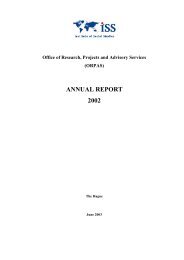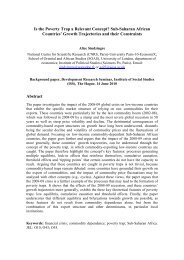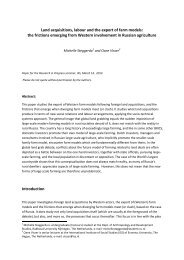Joint ventures in South Africa's land reform programme ... - ISS
Joint ventures in South Africa's land reform programme ... - ISS
Joint ventures in South Africa's land reform programme ... - ISS
Create successful ePaper yourself
Turn your PDF publications into a flip-book with our unique Google optimized e-Paper software.
estitution <strong>in</strong> the form of cash <strong>in</strong>come or even access to <strong>land</strong>”. Of particular concern to<br />
policy-makers and commentators has been a perceived decl<strong>in</strong>e <strong>in</strong> productivity on <strong>land</strong><br />
restored to restitution claimants and difficulties experienced by new owners <strong>in</strong> mobiliz<strong>in</strong>g<br />
the necessary skills and f<strong>in</strong>ance to engage <strong>in</strong> profitable enterprises.<br />
In response to the collapse of some high-value farms restored to claimants, the <strong>South</strong><br />
African government has promoted various forms of jo<strong>in</strong>t <strong>ventures</strong> between claimants<br />
and the private sector, commonly referred to as ‘strategic partnerships’ (Derman, Lahiff<br />
& Sjaastad 2006). Under this model, restitution claimants enter <strong>in</strong>to agreements with<br />
agri-bus<strong>in</strong>ess partners to manage the <strong>land</strong> on their behalf, with benefits to be shared<br />
between the partners (DLA, 2008). This approach has been particularly prom<strong>in</strong>ent <strong>in</strong> the<br />
Limpopo prov<strong>in</strong>ce where large areas of high-value agricultural <strong>land</strong> and associated<br />
facilities are <strong>in</strong> the process of be<strong>in</strong>g transferred to community groups. Although this<br />
model appears to have been imposed by the state as a condition for <strong>land</strong> restoration, it<br />
responds to a demand from claimant communities for technical and f<strong>in</strong>ancial assistance<br />
<strong>in</strong> manag<strong>in</strong>g large agricultural enterprises. For the private sector partners, some of them<br />
former owners of the <strong>land</strong> <strong>in</strong> question, it presents opportunities to preserve or even<br />
expand commercial activities with<strong>in</strong> the agri-food sector, albeit under new conditions.<br />
The abrupt withdrawal of a number of private sector partners <strong>in</strong> recent years, and the<br />
collapse of a number of large-scale projects, raises concern regard<strong>in</strong>g the viability of<br />
these jo<strong>in</strong>t <strong>ventures</strong> and highlights the need to fully <strong>in</strong>terrogate the expectations,<br />
<strong>in</strong>terests and motivations of the actors <strong>in</strong>volved.<br />
The move towards private sector <strong>in</strong>volvement <strong>in</strong> <strong>South</strong> African <strong>land</strong> <strong>reform</strong> clearly<br />
reflects ‘dom<strong>in</strong>ant development th<strong>in</strong>k<strong>in</strong>g’ not only <strong>in</strong> <strong>South</strong>ern Africa, but also globally<br />
(Br<strong>in</strong>kerhoff 2002; SLSA Team 2003). A central tenet of this th<strong>in</strong>k<strong>in</strong>g is that marketorientated<br />
strategies and private sector <strong>in</strong>volvement required basis for susta<strong>in</strong>able<br />
economic development. Private sector <strong>in</strong>volvement <strong>in</strong> development projects is thus<br />
<strong>in</strong>creas<strong>in</strong>gly seen as a way of meet<strong>in</strong>g social justice requirements whilst at the same<br />
time ma<strong>in</strong>ta<strong>in</strong><strong>in</strong>g productivity and profit. In many <strong>in</strong>stances, private sector <strong>in</strong>volvement is<br />
pursued <strong>in</strong> the form of ‘partnerships’. The term partnership is widely used but often very<br />
differently def<strong>in</strong>ed – to some it is a legally based contractual agreement, while to others<br />
4
















